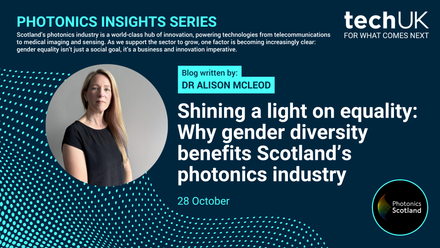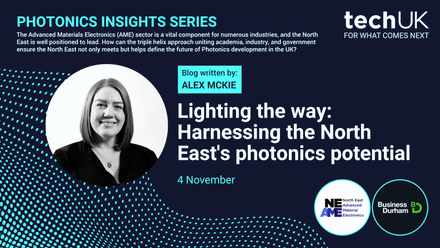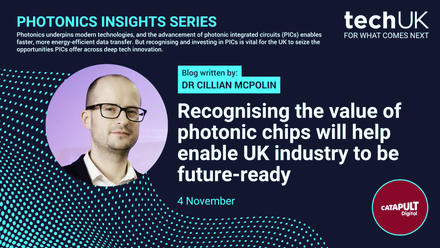Event round-up: Making the Most of the UK’s Photonics Clusters
Event round-up: Making the Most of the UK’s Photonics Clusters
techUK’s Photonics sprint campaign, a five-month initiative running from September 2025 to January 2026, is designed to accelerate Photonics innovation, spark cross-sector partnerships, and showcase best practice from techUK’s members and stakeholders. Please visit the link above or email [email protected] for more information.
This webinar bought together a panel of experts to explore how industry can best engage with the UK’s photonics clusters and better understand what support clusters offer for companies who are new or tangential to the photonics sector. With a particular focus on clusters in Northern Ireland, Southampton, and Scotland, the panel shared best examples of best practice, explored the current and future role of clusters in supporting the photonics landscape, and discussed how government and industry can work together to maximise the impact of these clusters.
Speakers included:
- Dr Andy Sellars, Director of Strategy, CORNERSTONE
- Elizabeth Patterson, Senior Program and Policy Manager, Seagate Technology
- Rachel Doherty, Cluster Facilitator, Northern Ireland Photonics Innovation Cluster
- Dr Alison McLeod, Director - Photonics Scotland, Technology Scotland
An overview of the UK's photonics landscape was delivered by Ella Shuter, techUK’s Junior Programme Manager for Emerging Technologies, while the webinar was chaired by Rory Daniels, techUK’s Head of Emerging Technology and Innovation.
You can watch the full recording here, or read our summary of the key insights below:
Please note that the below is a summary of the event, and readers are encouraged to watch the webinar to understand the full details of the discussion.
The session opened with a brief overview of photonics in the UK:
- Photonics (the science and technology of light) has wide range of use cases spanning medical devices, data transmission, sensing, laser applications and across industries such as defence, manufacturing, telecoms and more. Photonics is a £18.5 billion industry that employs over 84,000 people (more than the automotive or aerospace sectors).
- techUK’s Photonics Sprint Campaign is a five-month initiative aimed at exploring how the UK can lead in the development and deployment of photonics technologies. The campaign will bring together stakeholders from across the sector through a series of workshops, roundtables, networking events, and webinars to explore applications of photonics technologies, showcase best practice, and identify both the opportunities and challenges facing the photonics industry. Following the campaign, techUK will publish a report outlining key insights, policy recommendations, and case studies to inform government and industry on the actions needed to further support and grow the UK’s photonics sector.
- The UK is home to over 1,400 photonics companies, with this number continuing to grow every year distributed throughout the UK with notable strengths in regions from the Southwest to Scotland and Northern Ireland. These regiones are anchored by a world-class research bases spread across more than 40 universities focused on specific technologies such as optical fibres, lasers, and other core areas of photonics.
- Sustained support for research in these areas is essential to maintaining the UK’s global leadership in photonics, especially amid growing international competition for talent, investment, and research excellence from regions such as Asia, China, the USA, and Europe.
How would you define a photonics cluster and what sort of support do they offer?
- Whilst there is no formal definition, a photonics cluster consists of a geographical concentration of industry, academia and RTOs with a specific area of expertise, that seek to increase innovation and productivity, drive economic development and create a skilled workforce in that area to establish regional centres of excellence.
- SME Support - Smart Nano demonstrates how photonics clusters can play a role in scaling up SMEs through its 12-week accelerator programme that gives companies the opportunity to connect with industry and to support them conduct further prototyping and testing.
- Economic impact - Analysis conducted by the Southampton region shows that the economic impact of the cluster estimated to £250 million and has created jobs for 3,200 people in the Southampton region which is driven by spin out companies from the University.
- Representation of industry - Clusters add significant value to the photonics industry by raising the sector’s profile and providing a unified, neutral voice to represent the interests of businesses, researchers, and other stakeholders at the government level. This helps increase visibility and understanding of photonics both nationally and locally, while also fostering stronger collaboration across the ecosystem.
How can Industry Best Engage with the UK’s Photonics Clusters?
- Be proactive - Having a clear end goal and understanding how best to proactively engage with the cluster is key to getting the most value out of it. The more members actively engage with the cluster, the more benefit they gain. This includes sharing relevant updates, completing surveys, participating in advisory boards (where available), and generally taking part in the wider opportunities. Engaging in meetings, workshops, special interest groups, or networking events helps members stay informed and build valuable connections within the cluster.
- Shared Vision - Early on, there also needs to be a sense of intention to support setting a shared direction that allows industry to get the most out of a cluster. For example, photonics Scotland have published two vision papers one focused on photonics in Scotland, aiming to triple the size of the sector within a 10-year timeframe and the other focused on commercialising quantum technologies, helping Scotland capitalise on its strong research and innovation base. This kind of targeted, vision-led activity has proven effective in driving engagement and aligning the community around shared goals.
- Communication - Members should also feel comfortable going to clusters with issues, such as specific challenges they might be able to help with. It was suggested that each organisation should have an internal contact who takes ownership of the relationship, acts as the main point of contact, and helps ensure ongoing engagement and communication.
- Smart Nano is a strong example of industry engagement with deep connections to local educational institutions. It leverages the region’s talent pool while also aligning with other local industry strengths. Local SMEs are actively involved, supported through various initiatives such as the accelerator programme, which helps smaller companies scale and grow. At the heart of all this is a shared vision: to establish Northern Ireland as a regional centre of excellence in this field.
- Special Interest Groups are a way of bringing industry together around a shared focus area, such as to explore the key issues facing the sector, whether that's access to infrastructure, new facilities becoming available or how these resources can support the broader photonics and quantum ecosystem across or sharing information on upcoming events, funding opportunities, and collaborative projects.
How Can Industry and Government Support Clusters to Maximise their Impact?
- Support Startups to Scale-Ups - While clusters can provide prototyping capabilities and some early-stage funding, the real challenge lies in securing the necessary investment to help companies scale. Greater support for scaling businesses will not only incentivise companies to remain in the UK but also attract international businesses. A survey conducted by Photonics Scotland highlights that the biggest barrier to growth for photonics organisations in Scotland is access to capital, followed by a lack of skilled talent and limited access to markets.
- Address the Lack of Long-Term Financial Planning - Long-term financial planning remains a challenge in the UK, with funding often focused on short-term cycles. UKRI’s Strength in Places fund, for example, typically operates on two- to three-year cycles both in terms of disbursement and project timelines whereas cluster roadmaps often span five to seven years making it difficult for clusters and businesses to plan and deliver strategic projects effectively. Adopting a longer-term approach to financial planning would provide greater stability and strategic direction for companies and unlock significant growth.
- Recognise and engage clusters as a collective - Direct communication to gather insights, feedback, and strategic input would position clusters as a trusted, coordinated voice. Government should proactively reach out and engage with clusters in a structured and consistent way to support more informed decision making.
- Promote the strength of the UK's Photonics clusters internationally - The UK has strengths in photonics research and innovation, which should be harnessed on the international stage to support the scaling of companies .The Southampton photonics cluster, for example, is experiencing impressive growth, with an annual rate of 10%, far surpassing the UK average of 1.7%. This highlights the region's strong potential and the strategic value of investing in and promoting such high-performing clusters internationally.
How do you think, if at all, the UK’s Photonics cluster landscape is set to change in the next 5 – 10 years?
- Proper accreditation schemes as part of a plan to formalise the cluster landscape - The Scottish Government have a plan in place to formalise clusters and ensure that cluster management organisation uphold certain standards. The hope is that this will bring all clusters on a more level playing field and encourage better communication between the different technology clusters in Scotland.
- Greater coordination between clusters is essential to position the UK as a unified, single entity, rather than a collection of fragmented regional entities that represent regional clusters. This will avoid duplication, enable more strategic collaboration, and allow each cluster to contribute its unique strengths to national goals to deliver tangible, impactful outcomes that support the UK’s technology and innovation landscape. The recent announcement of funding for a UK Semiconductor centre is an example of efforts that enable great coordination between clusters across the UK.
If you'd like to continue the conversation or get involved in the sprint campaign, please get in touch with our team below.










